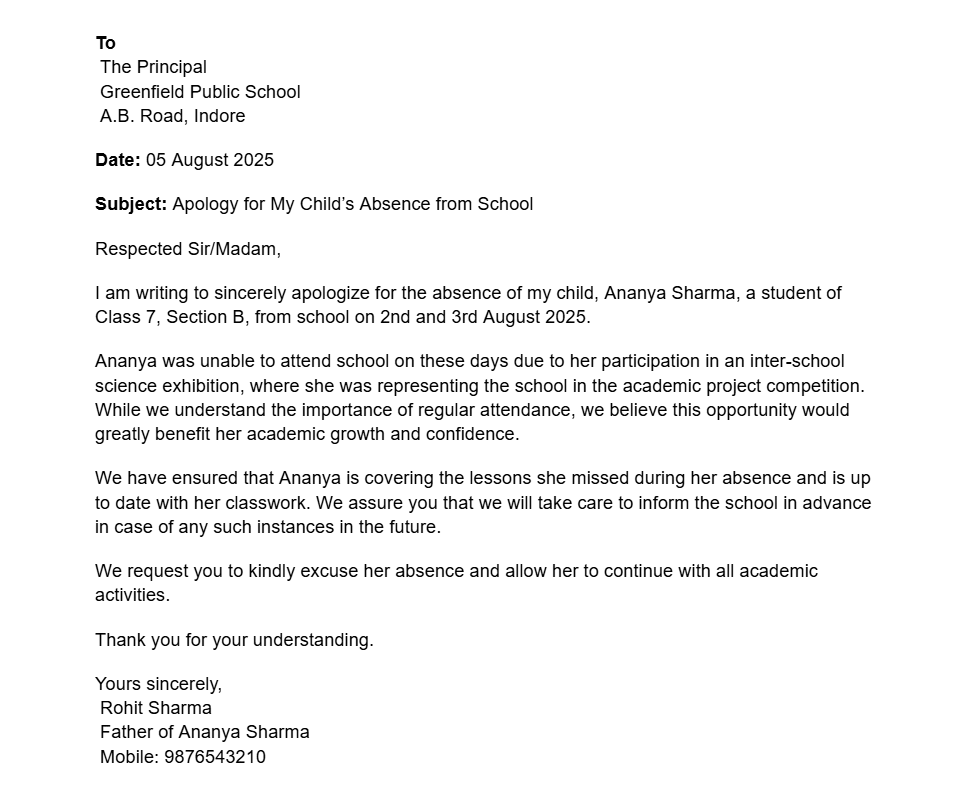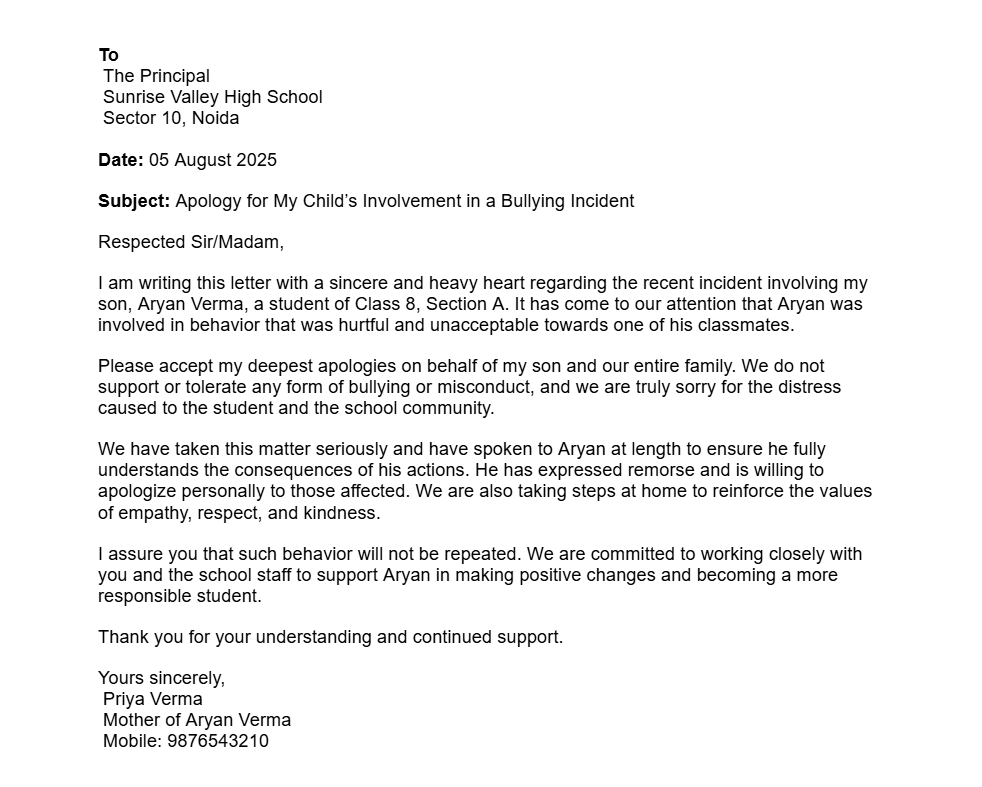Apology Letter Format
Mastering the apology letter format is an essential skill, especially for students, as it helps convey sincerity and responsibility when words are hard to say in person. Many people find it hard to apologise sincerely. A heartfelt letter can go a long way in mending relationships, clearing up misunderstandings, or showing accountability.
Have you ever argued with a classmate or forgotten to inform your teacher about an absence? Or did you submit your work late without explanation? In these cases, a well-written apology letter can help fix misunderstandings and show that you are willing to take responsibility.
In this guide, we’ll teach you exactly how to write an apology letter that sounds honest and respectful. To make things easier, we have also included a sample apology letter template you can use in various situations.
Table of Contents
- What is an Apology Letter Format?
- Why Do You Write an Apology Letter?
- How to Write an Apology Letter Format
- Apology Letter Format Samples
- Common Mistakes to Avoid in Apology Letters
- Frequently Asked Questions on Apology Letter
What is an Apology Letter Format?
An apology letter format is a structured way of saying sorry for a mistake or wrongdoing. It follows a step-by-step pattern so the message is clear and respectful. Using the correct apology letter format helps you get the right response, especially in school, exams, job applications, or workplace situations.
Why Do You Write an Apology Letter?
An apology letter accomplishes several significant goals. You can use it to:
-
Apologise and express regret for the things you did that made a person feel bad.
-
Instead of making excuses for what went wrong, take responsibility. Admitting mistakes shows maturity.
-
Express your wish to make amends and your honest request for the person’s forgiveness.
-
Through sincere apologies, both the person who made the mistake and the one who faced it can rebuild their broken trust.
-
Emphasise that, in light of the lessons learnt, such incidents will not occur again.
-
Writing your instructor a thoughtful letter of apology might help to patch up the relationship and open the door to a new beginning.
How to Write an Apology Letter Format
An apology letter is a formal letter in writing or mail submitted to the concerned person affected by your action as an act of repentance. Most of us would have had the experience of writing at least a letter to the principal when we were students to apologise for coming late to class or missing a test.
One of the major challenges you would face when writing an apology letter is choosing the right words. You have to make sure you write the apology letter in a polite tone. You have to understand the difficulty caused as a result of your actions and show that you are truly sorry for what you have done.
Making someone feel your regret can be tough. In order to do that, make sure you do not make any excuses, even if what happened was not entirely your fault. Here’s a simple and effective format you can follow. It’s explained clearly so that students can learn it easily, and parents or teachers can guide them too.
1. Date and Sender’s Information
Start by writing the date at the top, followed by your name, class, and school (if you’re a student). This helps the reader know who the letter is from.
2. Receiver’s Details
Next, write the details of the person you’re addressing. This could be your teacher, principal, or any concerned authority.
3. Subject Line
Include a short subject line that clearly states the purpose of the letter, like:
"Subject: Apology for Misbehavior in Class"
This sets the tone for what the letter is about.
4. Opening Greeting
Begin with a respectful greeting such as:
"Respected Sir/Madam," or "Dear Teacher,"
5. Apologize Clearly
Start by saying you're sorry and explain what you're apologising for. Be direct and sincere.
Example: “I sincerely apologise for my behaviour during yesterday’s class. I now realise it was wrong of me to speak out of turn.”
6. Briefly Explain the Situation.
You may explain what led to the mistake, but don’t make excuses. Keep it simple and honest.
Example: “I was feeling upset due to a personal issue and didn’t manage my emotions properly, which led me to act inappropriately.”
7. Take Responsibility and Express Regret
Let the reader know that you understand your mistake and feel truly sorry for it.
Example: “I understand that my behaviour was disrespectful, and I regret not following classroom discipline.”
8. Assure Improvement
Give assurance that such behaviour will not be repeated and that you are working to improve.
Example: “I will be more mindful in class and ensure that I follow all the rules moving forward.”
9. Thank the Reader
End the letter by thanking the person for understanding and for giving you a chance to apologize.
10. Proper Closing
Use a polite closing phrase such as
-
Yours sincerely,
-
Yours obediently,
-
With respect
Then sign your name and mention your class or position.
Apology Letter Format Samples
We write apology letters depending on various situations, the person you're addressing, and the seriousness of the issue. To help you express your apology clearly and respectfully, we’ve included a variety of apology letter samples suited for different occasions; whether it’s a student addressing a teacher, a parent writing to the school, or someone owning up to a mistake in a work, these samples are easy to customise. They follow a polite and formal tone, making it simpler for you to communicate sincerely and effectively.
-
Apology Letter to Principal from Parent for Child’s Misbehavior in Class
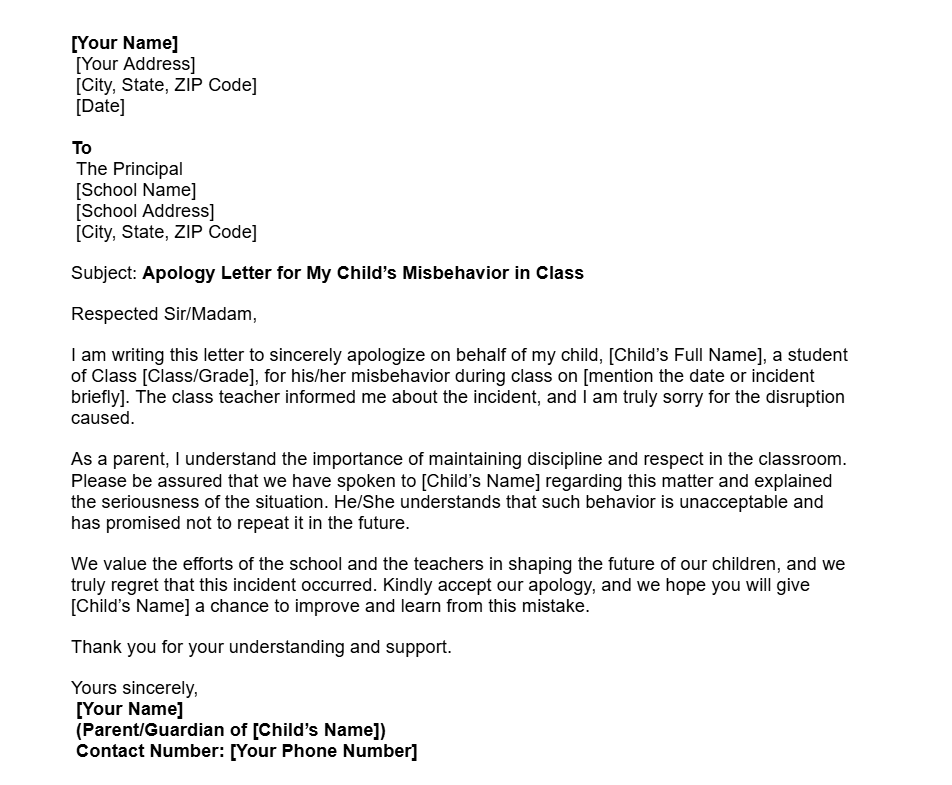
-
Apology Letter for Missing School Without Permission

-
Apology Letter from Parent for Child’s Absence
-
Apology Letter to Principal from Parent for Child’s Bullying Incident
-
Apology Letter for Damaging School Property
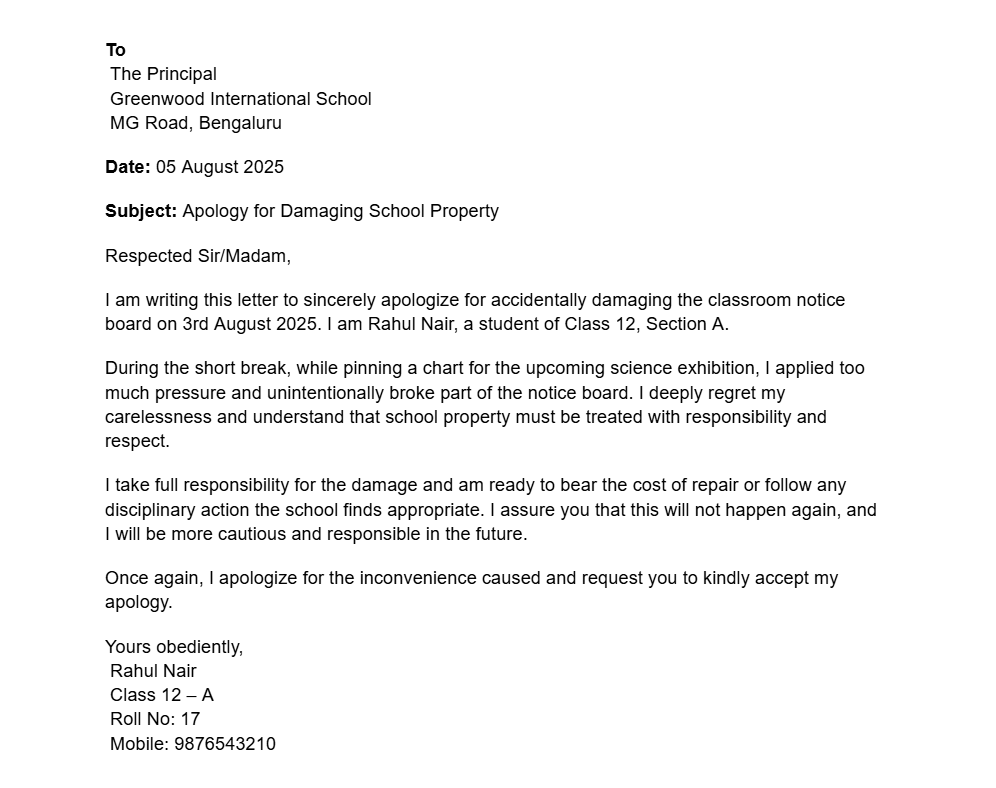
-
Apology Letter for Breaking a School Rule

-
Apology Letter from Parent for Child’s Poor Performance
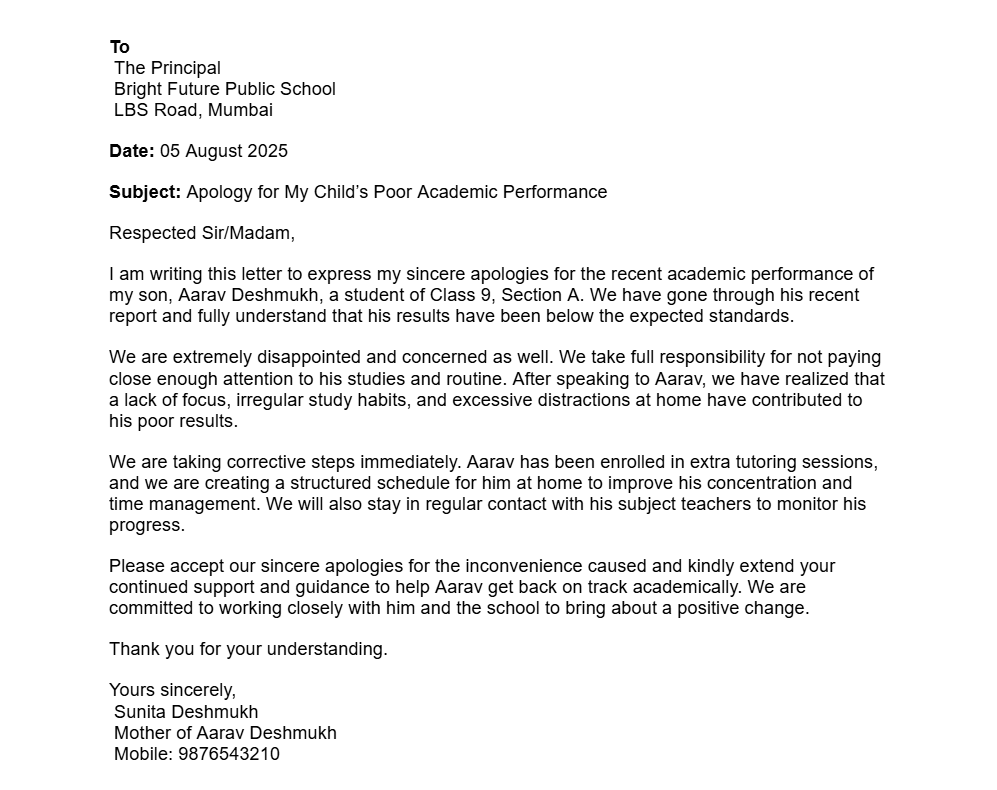
-
Apology Letter from Parent for Child’s Inappropriate Language
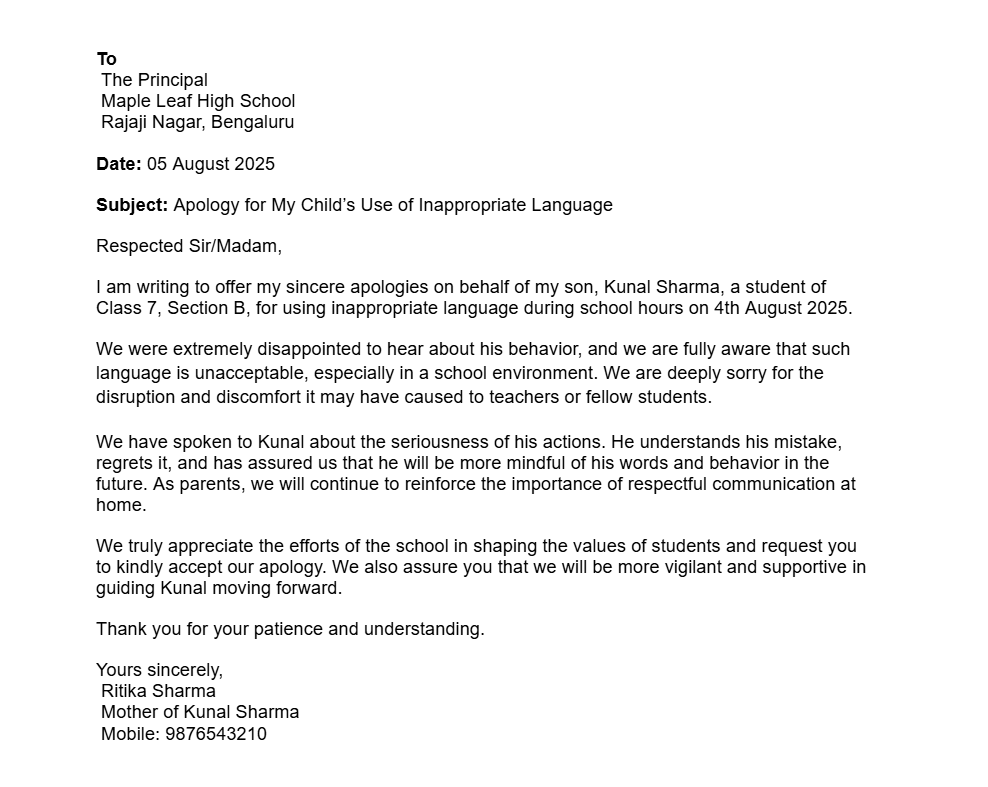
Common Mistakes to Avoid in Apology Letters
-
Blaming others for the mistake.
-
Using impolite or casual words in formal situations.
-
Being too brief or missing important details.
-
Repeating excuses instead of apologizing.
-
Forgetting to mention how you will correct your error.
Frequently Asked Questions on Apology Letter
-
How do you write an apology letter?
Answer: To write an effective apology letter, begin with a clear and sincere apology, take responsibility for the mistake, and acknowledge the harm caused without making excuses. Then, offer a concrete plan to rectify the situation or make amends, and assure the person that the incident won't happen again. Conclude by reiterating your apology and expressing hope for reconciliation, ensuring the letter is brief, humble, and free of blame or further justifications.
-
How do you apologize to someone you hurt deeply?
Answer: To sincerely apologize for hurting someone deeply, acknowledge the specific harm caused. Express genuine remorse, take responsibility for your actions, and offer to make amends. Avoid making excuses or downplaying the impact of your words or actions. Focus on their feelings and validate their experience.
-
How to respond to apology letter format?
Answer: To respond to an apology letter, thank the sender. Share your feelings and state whether you accept their apology. You can say, "I accept your apology" or "You're forgiven." If you need more time, express that too. You might also set boundaries for future interactions, thank them for their honesty, or acknowledge your own role in the situation.
Admissions Open for
Admissions Open for
CBSE Schools In Popular Cities
- CBSE Schools in Bangalore
- CBSE Schools in Mumbai
- CBSE Schools in Pune
- CBSE Schools in Hyderabad
- CBSE Schools in Chennai
- CBSE Schools in Gurgaon
- CBSE Schools in Kolkata
- CBSE Schools in Indore
- CBSE Schools in Sonipat
- CBSE Schools in Delhi
- CBSE Schools in Rohtak
- CBSE Schools in Bhopal
- CBSE Schools in Aurangabad
- CBSE Schools in Jabalpur
- CBSE Schools in Jaipur
- CBSE Schools in Jodhpur
- CBSE Schools in Nagpur
- CBSE Schools in Ahmednagar
- CBSE School In Tumkur

